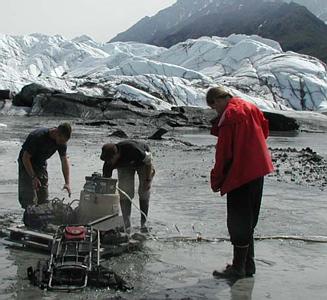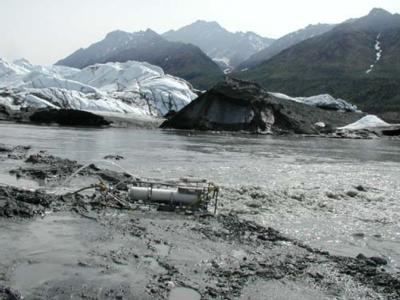5 July, 2000
July 5, 2000
Matanuska Glacier, Alaska
Not long after the sun dips behind the Talkeetna Mountains to the west
and north the air takes a noticeable drop in temperature and clouds
begin to form around the mountains. When morning rolls around the
mountains seem fully enclosed in clouds and there’s a good chill in the
air. As a result the workdays starts a bit later in order to take
advantage of better temperatures. Usually it is a goal to get out by
9:00 in the morning and earlier only if there’s a pressing need for it.
Temperatures rise and remain at a very comfortable level into the early
evening hours. This morning a constant but light rain was falling and
although everyone was awake and ready to go out for the day, we held
back to see if the sun might burn off some clouds and lighten things up
a bit. However, an ISCO water sampler needed attention before noon and
so we headed out in the rain at 10:00 to the north vent station.
A vent is a location near the terminus of the glacier where there is an
upward discharge of water that has been flowing in and under the glacier
and is now coming out to create surface runoff. There are a number of
these large vents on the Matanuska glacier and each is referred to with
a different name for obvious reasons. The water coming out of a vent is
under fairly high pressure due to the weight of all the water in the
subglacial drainage system above that feeds into it. This results in
water coming out that is supercooled and freezes upon reaching “normal”
pressures at the surface. A supercooled liquid is one whose temperature
in the liquid state is below the “normal” freezing point. This commonly
occurs to liquids under pressure. When the pressure drops to normal, the
liquid begins to freeze to some extent. This same phenomenon is observed
occasionally when you open a really cold soft drink. Soon after opening
the container the drink begins to get slushy as the supercooled liquid
starts to freeze under the lowered pressure.
When visiting an ISCO station one problem to watch for, and a serious
one at that, is that the instruments that have been placed in the vent
can get frozen in place. At a number of these stations other data
collecting devices are attached with the ISCO collection tube and could
be frozen in with it. At stream side stations there is always a watchful
eye kept on rising stream levels as the melting increases into the
summer season. Quite often the ISCO must be moved to higher ground. In
addition, some of the vents are surging out right at the edge of
unstable ice ledges and a concern is for a section of the ice to break
off and wash downstream. At these stations the ISCO is kept a fair
distance from the edge and longer lengths of tubing are used to draw in
the water sample. It is also essential to check that the instrument is
still powered and operating correctly.
The ISCO is a device that can be programmed to collect up to 24 unique
water samples through tubing that connects from the device to the water
source. It looks like a very large industrial size vacuum cleaner.
Currently the ISCO’s in place at various stations are collecting samples
every two hours and must be visited every two days in order to install a
fresh set of empty sample bottles and check for any problems. At some
stations, daily visits are required to check for some of the problems
mentioned earlier. Ben and I will be utilizing these devices in our
research and this morning we learned about their operation and things to
watch for when checking up on them. There’s still more features of the
glacier to explore and learn about before we can begin our research.
Tomorrow we’ll find out more about this massive river of ice. Till
then.....
Marvin Giesting

Justin Pierce on the right patiently teaches me how to program the ISCO water sampler.

This ISCO station is being placed on a wooden pallet to keep it off the thick glacial silt that oozes along on the surface of the ice shelf here. This shelf may be a bit unstable so we're placing it about 60 feet or so from the edge. The ISCO is tied down to the pallet and is weighted with rocks because ice breaking from the edge could cause the ropes to pull quickly on it and possibly slide it along or pull it in completely. Josh Lawson on the left is helping Justin Pierce as Ben Burnette looks on.

Here's a good look at one of a series of numbered vents in an area called Mammoth Vent. How many vents there are in this area may change from year to year as old ones may plug up and new ones form. You can see the upwelling water just at the edge of the ice. Ropes are attached to the instruments and it is thrown into the vent to collect data.
Contact the TEA in the field at
.
If you cannot connect through your browser, copy the
TEA's e-mail address in the "To:" line of
your favorite e-mail package.
|
